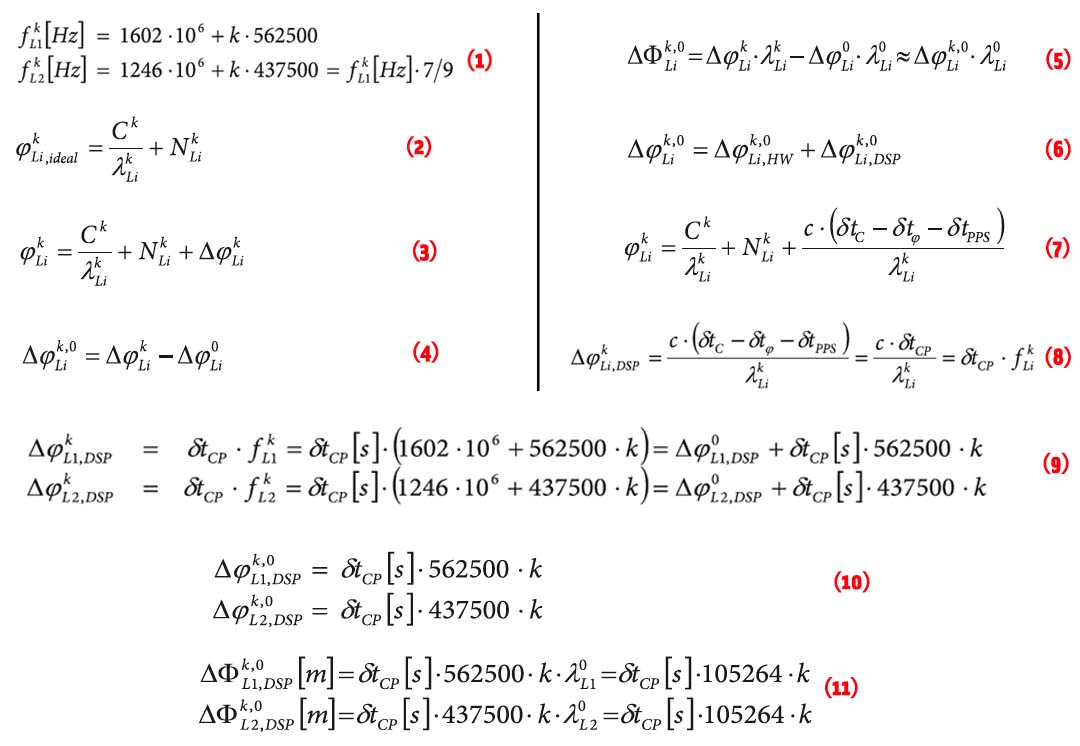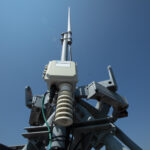Q: What is the carrier phase measurement? How is it generated in GNSS receivers?
A: Simply put, the carrier phase measurement is a measure of the range between a satellite and receiver expressed in units of cycles of the carrier frequency. This measurement can be made with very high precision (of the order of millimeters), but the whole number of cycles between satellite and receiver is not measurable.
A good analogy to this is to imagine a measuring tape extending from the satellite to the receiver that has numbered markers every one millimeter. Unfortunately, however, the numbering scheme returns to zero with every wavelength (approximately 20 centimeters for GPS L1). This allows us to measure the range very precisely, but with an ambiguity in the number of whole carrier cycles.
A number of subtleties must be considered when generating these measurements in a receiver. To fully appreciate these requires a more detailed look at what we mean precisely when discussing the carrier phase.
All current GNSS satellites transmit radio frequency (RF) signals in the L-band. These signals consist of, at the very least, an RF carrier modulated by a pseudorandom noise (PRN) code. When discussing the phase of a signal it is important to realize that phase is fundamentally a property of sinusoids. Every sinusoid has an amplitude and a phase and can be written in complex notation as Aexp j(ωt + θ), where A is the amplitude, ω is the radial frequency, and θ is the phase in radians at t = 0.
When the RF carrier is modulated by a PRN code, the resulting signal is no longer a pure sinusoid but can, by Fourier’s Theorem, be expressed as a linear combination of sinusoids. The concept of the phase of a combination of sinusoids is less clear than that for a single sinusoid (e.g., how do we define the phase of the sum to two sinusoids?).
For GNSS signal processing we define the signal phase to be the phase of the carrier signal. In other words, this is the phase of the pure sinusoid that would result if the PRN code and any other modulations are “wiped off.” In the following discussion, when we mention the signal phase, this is what we shall be referring to.
. . .
If the receiver can estimate the received RF phase, then three unknowns remain that must be estimated in order to determine the range. These are:
1. The receiver time trx
2. The initial satellite phase offset ϕs (0)
3. The integer number of cycles between satellite and receiver.
In most carrier phase processing applications, the effects of the first two are removed by differencing of observations; differencing between satellites removes errors in the receiver time component, while differencing between receivers removes errors in the satellite phase offset.
So, how does the receiver generate an estimate of the carrier phase observation? The short answer is by integrating the Doppler frequency (hence, why the carrier phase measurement is often called the accumulated Doppler range), but this does not address the original question.
. . .
A number of problems arise with generating the carrier phase measurement in this way, however. First, note that we can consider the NCO phase to consist of two components, one due to the intermediate frequency and another that is just due to the range between satellite and receiver.
Consider the simple case of an IF of 0 Hz. In this case the NCO phase consists only of the range component, and the carrier phase measurement can be obtained directly as the negative of the NCO phase . . .
To generate useable phase measurements, the receiver phase observations must maintain a constant integer number of cycles offset from the true carrier phase.
. . .
This phase bias term is therefore different for each satellite, which could cause significant problems in processing these measurements. However, a receiver designer is free to choose the initial value of the NCO phase and thus can ensure that this bias is the same for all satellites.
One simple way to do this is to mix the IF signal down to zero, thereby reverting to the zero IF case. An alternative is to store a globally accessible IF phase accumulator in the receiver. This can be arbitrarily initialized when the receiver is turned on, and its phase is updated continuously during receiver operation. Whenever a PLL starts to track a signal, the IF component of its NCO phase is initialized to that of the global IF phase accumulator.
. . .
In summary, the carrier phase measurement is a highly precise measure of the pseudorange between satellite and receiver, the generation of useable carrier phase measurements in a receiver requires a phase locked loop, and the receiver designer must take care to ensure that 1) the integer ambiguity term is constant, and 2) the initial phase is chosen so as to ensure a common phase bias in all tracking channels.
(For Cillian O’Driscoll’s complete answer to this question, including formulas and tables, please download the full article using the pdf link above.)





